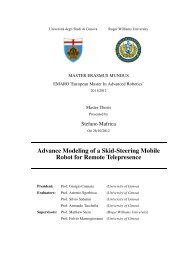CAMPUS PLANNING - Roger Williams University
CAMPUS PLANNING - Roger Williams University
CAMPUS PLANNING - Roger Williams University
You also want an ePaper? Increase the reach of your titles
YUMPU automatically turns print PDFs into web optimized ePapers that Google loves.
2002-2003 RWU Presidential Fellowship Report: Campus Planning<br />
1. Building a love of learning as an intrinsic value<br />
2. Preparation for careers and future study<br />
3. Development of undergraduate research<br />
opportunities<br />
4. Service to the community<br />
5. Creating a global perspective<br />
6. Nurturing a caring and respectful community<br />
History / Identity<br />
Institute<br />
The <strong>University</strong>’s roots can be traced back to 1919, when<br />
Northeastern <strong>University</strong> School of Commerce and Finance<br />
opened a branch at the Providence YMCA. The next year,<br />
Northeastern’s School of Law opened a Providence<br />
division, offering a LL.B. degree. Northeastern’s presence<br />
in Providence grew again in 1938, when the <strong>University</strong><br />
opened the Providence Technical Institute, offering a<br />
certificate program in mechanical engineering.<br />
After an amicable agreement to separate from Northeastern<br />
in 1940, the YMCA Board of Directors established the<br />
Providence Institute of Engineering and Finance. The new<br />
institute was only in its second year when the outbreak of<br />
World War II forced its closing for the duration of the war.<br />
The School reopened in 1945 under a new name: The<br />
YMCA Institute of Engineering and Finance. Over the next<br />
five years the Institute grew, serving veterans through both<br />
the evening division and the newer day division. An<br />
important milestone was reached in 1948, when the state<br />
authorized the Institute to grant an Associates Degree.<br />
Junior College<br />
As the Institute grew, the need for its separation from the<br />
YMCA became increasingly apparent, and in February of<br />
1956, it received a state charter to become a two-year<br />
degree granting institution under the name of <strong>Roger</strong><br />
<strong>Williams</strong> Junior College. The new Junior College, the<br />
states first, began offering liberal arts studies in 1958 and in<br />
1964 the liberal arts program was established leading to an<br />
Associate in Arts degree.<br />
College<br />
By the early 1960s, the institution, still based at the<br />
Providence YMCA, was growing rapidly. As a result of<br />
that growth, and the state’s decision to create its own public<br />
junior college, the school sought approval to become a<br />
four-year college. The College acquired 63 acres of<br />
waterfront land in Bristol from the Fulton family and in<br />
1969 completed construction of its new campus. The<br />
Providence campus, 1,000 students strong, continued to<br />
house the Business and Engineering Technology programs.<br />
The new Bristol campus offered a full liberal arts program,<br />
enrolling 1,500 students. In addition, the College offered<br />
evening programs in both Providence and Bristol.<br />
<strong>University</strong><br />
Today, full-time day and evening program are offered at<br />
the Bristol Campus and evening courses and selective day<br />
courses are offered at the Providence Campus. The College<br />
of Arts and Sciences and the Schools of Business,<br />
Engineering, Justice Studies, Law and the School of<br />
Architecture, Art & Historic Preservation are now housed<br />
7
















